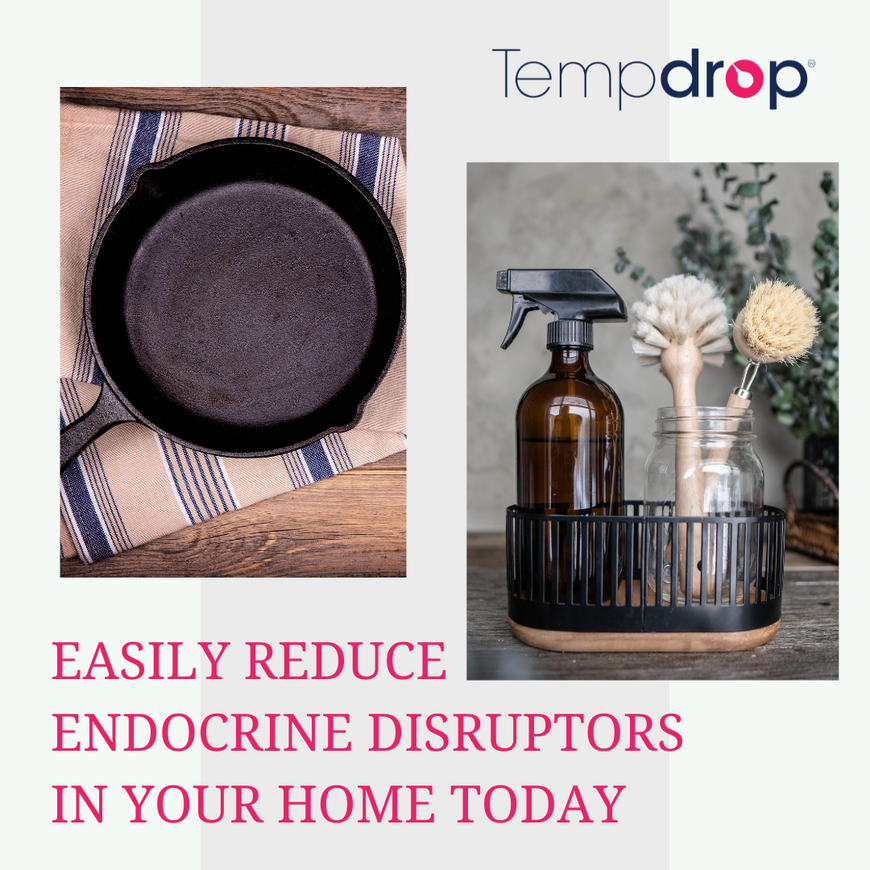Written by Gabby Borgerink
Earlier this week Tempdrop published a blog about endocrine disruptors. Basically, endocrine disruptors are chemicals that can actually mimic our own estrogen. Unfortunately, these chemicals are much more potent than our naturally made estrogen so when they dock onto estrogen receptors they can cause a lot of havoc. Even at very low levels, endocrine disrupting chemicals can disrupt hormone levels in your body. They have been linked to

- PCOS
- Endometriosis
- Estrogen dominance
- Thyroid disturbance
- Decreased fertility
- Increased risk of miscarriage
- Decreased semen quality
These chemicals can commonly be found in our skincare products, lotions, cleaners, food, plastic products, and more.
Some common chemicals that are endocrine disrupting:
- Bisphenol A (BPA) - commonly used in plastic products (plastic toys, water bottles, containers, etc)
- Pesticides and herbicides - chemicals used in agriculture (RoundUp, glyphosate, etc)
- Phthalates - It is used to enhance durability and elasticity of products (plastic wrap, hair products, nail polish, etc)
- Perfume/fragrance - used in home and personal care products (fabric softeners, scented candles, body sprays, lotions, etc)
- Perfluorinated chemicals (PFCs) - chemicals used to make pans non-stick (teflon, etc)
- Triclosan - antibacterial agent commonly found in hand wash, dish soap, etc
Everything we come into contact with is directly absorbed into the body through our skin. If you list out all of the products in your daily routine you will soon notice all of the areas you can possibly be exposed to chemicals.
You don’t need to run out and replace everything all at once, but once a product is used up in your home, start to replace it with better alternatives. You can also look at the products you use the most and opt to change those ones first since you have the most exposure on a day-to-day basis. It's not about being perfect, but rather limiting exposure where you can and being mindful of it.
In most cases, the natural options are cheaper, or you don't have to buy as many products. Win-win for your health and wallet!
Where are some areas you can limit chemical exposure?

-
Scented products
Why: Most scented products use parfums, fragrance and chemicals to create a potent smelling scent that lasts long.
Instead: look for naturally scented products with essential oils, plant-derived ingredients or simply unscented. -
Home cleaners
Why: Most store bought cleaners contain harmful chemicals and strong fragrances that can contribute to health issues.
Instead: use vinegar and water to make a homemade cleaner in a spray bottle. It can clean just as well as any store bought cleaner and can be used on any surface in the home. You can add your own essential oils for scent or keep it simple. For harder to clean spots, use baking soda to scrub. If you must use a strong cleaner, make sure the area is well-ventilated and you wear rubber gloves so it doesn’t absorb through your skin. -
Storage containers
Why: Plastic containers leach chemicals. They also leach much more when heated or cooled to extreme temperatures, or if there is a fat/oil being stored in it.
Instead: Buy glass storage containers or, simply start saving old jars from pasta sauce, pickles, honey, jams, etc. And if you have to use plastic to store food, avoid heating food in it or storing it in the freezer. -
Cookware
Why: Most non-stick cookware contains PFCs (perfluorinated chemicals) that can disrupt normal endocrine function. These types of cookware when scratched or damaged can also be more hazardous exposing more chemicals to be leached into your food that is being cooked.
Instead: look for cast iron (that is properly seasoned), stainless steel or ceramic coated options.


